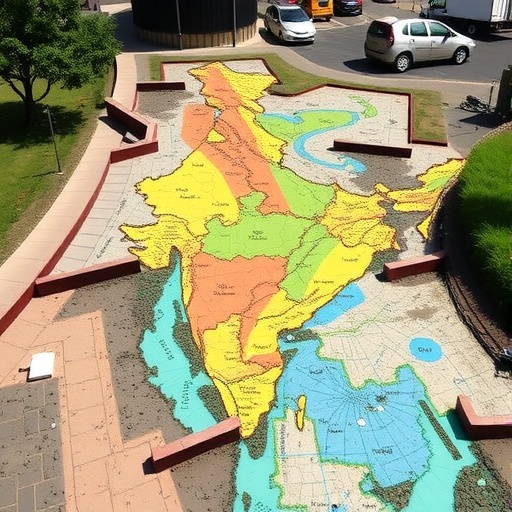In an era where climate change and extreme weather events pose significant challenges to water resources, the importance of sustainable groundwater management cannot be overstated. The need for innovative solutions to ensure a reliable water supply, especially in drought-prone regions, has become imperative. A recent study conducted by Saha and Pal delves into the delineation of groundwater potential zones utilizing data-driven approaches in Eastern India, a region notorious for its water scarcity. This research highlights the crucial intersection of technology and environmental science in safeguarding water resources.
The researchers employed various data-driven methodologies to assess groundwater potential in a region that often experiences severe drought conditions. Their approach is noteworthy because it integrates diverse datasets, including remote sensing imagery, geological maps, and soil characteristics, creating a holistic view of groundwater availability. These methodologies are pivotal for enhancing our understanding of groundwater resources and fostering effective management strategies.
Groundwater serves as a vital resource for millions, particularly in agrarian societies where irrigation is necessary for crop production. In Eastern India, where monsoonal patterns are unpredictable, reliance on surface water alone is often inadequate. This exacerbates the situation for farmers and communities that depend on consistent water supplies for their livelihoods. Saha and Pal’s work shines a light on methods to accurately identify areas that hold the greatest potential for groundwater extraction, ensuring that water resources are utilized efficiently.
The research presented in their paper is predicated on advanced data analytical techniques. By utilizing machine learning algorithms and spatial analysis, the authors were able to create sophisticated models that predict groundwater potential. These models analyze various environmental factors, such as topography and land use, to draw insights about groundwater presence in the subsurface. This predictive capacity is instrumental in making informed decisions about where to invest in water extraction technology and infrastructure.
One of the highlights of Saha and Pal’s study is the emphasis on sustainability. The authors propose that with strategic planning and precise data analysis, regions experiencing chronic drought can achieve a sustainable water supply without over-extracting groundwater resources. This is particularly vital, as improper management can lead to groundwater depletion—a reality that many regions are facing today. The delicate balance between utilization and preservation is key to long-term water security.
Additionally, the implications of this research extend beyond merely mapping potential groundwater zones. The methodologies detailed by Saha and Pal can be replicated in other drought-prone areas across the globe. This adaptability underscores the potential for localized solutions to a pressing global issue. By sharing their findings, the researchers contribute to a broader understanding of sustainable water management practices that can benefit various countries grappling with similar challenges.
The study also encompasses the importance of stakeholder engagement in implementing the data-driven insights garnered from their research. For effective water management policies to be adopted, local communities and decision-makers must be involved in the conversation. It is not merely about identifying where groundwater exists, but ensuring that those who rely on this resource are part of the decision-making processes surrounding its use.
In light of environmental stressors, the authors assert that traditional water management practices are inadequate for dealing with the complexities presented by climate change. Saha and Pal’s innovative approach introduces new perspectives on how technology can be leveraged to tackle this ongoing crisis. Their research not only encapsulates the urgency of the issue but also offers actionable solutions that pave the way for sustainable practices.
Ultimately, the study showcases the potential of data-driven approaches to enhance groundwater resource management. By highlighting specific zones with high groundwater potential, this research acts as a blueprint for future investigations and policy reforms aimed at conservation. The outcomes of such studies can provide the underpinnings for systematic efforts to combat water scarcity in regions vulnerable to drought.
Moreover, the use of remote sensing technology plays a vital role in this research, allowing scientists to gather information over large areas without direct ground access. This approach not only saves time and resources but also ensures a more comprehensive understanding of the environmental factors influencing groundwater availability. Such technological advancements can revolutionize traditional methods of resource mapping and management, marking a significant shift in how scientists approach environmental challenges.
As societies navigate the challenges posed by diminishing water supplies, it is crucial that research like that of Saha and Pal is disseminated widely. Their findings offer hope and guidance, suggesting that with the right tools and data, sustainable groundwater management is possible. This research not only addresses immediate needs but also lays the groundwork for long-term sustainability and resilience against climate-related adversities.
The collaboration of various scientific fields—geology, environmental science, and data analytics—is crucial in addressing the complexities of water management. Saha and Pal’s interdisciplinary approach exemplifies how collaborative efforts can lead to innovative solutions in overcoming environmental challenges. As future research builds on their findings, the potential for creating extensive frameworks for groundwater management across different ecological contexts is promising.
In conclusion, the delineation of groundwater potential zones through data-driven methodologies is not merely an academic exercise; it is an urgent response to one of the most pressing issues facing humanity today. Saha and Pal’s work in Eastern India serves as a model for how scientific inquiry can directly affect policy and practice, offering insights that can lead to sustainable water management worldwide. As we move forward, embracing technology and data-driven research will be key in our endeavor to protect and manage one of our most precious resources: water.
Subject of Research: Groundwater potential zones delineation in drought-prone regions of Eastern India using data-driven approaches.
Article Title: Delineation of groundwater potential zones using data-driven approaches: towards achieving sustainable groundwater management in drought-prone region of Eastern India.
Article References:
Saha, A., Pal, S.C. Delineation of groundwater potential zones using data-driven approaches: towards achieving sustainable groundwater management in drought-prone region of Eastern India. Environ Monit Assess 197, 1090 (2025). https://doi.org/10.1007/s10661-025-14554-w
Image Credits: AI Generated
DOI: 10.1007/s10661-025-14554-w
Keywords: Groundwater management, data-driven approaches, drought, Eastern India, sustainability.




